Despite what you may have heard, and contrary to what some historians may be saying in the months and years to come, our Civilian Conservation Corps and the Reich Labor Service of Nazi Germany were the offspring of two distinct ideologies and the programs approached their task from vastly different perspectives.
An in depth discussion and explanation of the CCC is not warranted here, except as it compares to its German counterpart but it may help to have a brief description of the German Reicharbeitsdeinst or RAD; the German National Work Service. The RAD was created in 1934 as the official labor service of the German state and the Nazi party. The RAD was an outgrowth of previous labor organizations that existed largely as a result of the economic hardships being faced by Germany in the 1920s and 1930s. In their initial manifestation, these labor organizations focused on supplying labor for agricultural related duties and relieving some of the strain of high unemployment – remember that the Great Depression was a worldwide depression and Germany likely suffered more as a result of her defeat in World War I. With the consolidation and renaming of various labor services over time, and the rise to power of the Nazis under the leadership of Adolf Hitler, six-month service in the newly named RAD became compulsory for young men aged 18 to 25. Upon completion of their RAD service, the young men then entered military service. (An exemption was given to young men who signed up for officer training, in which case their compulsory RAD service was waived.)
Knowing what we know, it’s difficult to understand how a historian or scholar could closely align the American CCC with the German RAD, but some have done it and in years to come, more may do so. Who knows why they’ll do it? They’ll do it because it’s fashionable to equate something noble with something sinister. They’ll do it to prove Franklin Roosevelt was a bum, or the New Deal a scam. They’ll do it because there’s nothing else to write about and they must publish something or risk losing their grant money, thereby slipping into that awful group of folks who have to work for a living.
Stated simply, we know the difference. Young Germans were compelled to join their nation’s labor service. Young men in America often begged to be allowed to enroll in the CCC and were occasionally turned away several times before gaining entry. In their first few weeks in the German National Work Service, young Germans learned military drill and the manual of arms (using a shovel instead of a rifle) before they ever set foot on a work site. In the United States, a distinct line was drawn between the work project and the limited influence of the military running the camps. Finally, no CCC enrollee embarked for combat against a foreign enemy and while many a former CCC enrollee earned a medal for valor, serving in some faraway place, he did so with his CCC service behind him and in the distinctly different uniform of the U.S. Marines, Army, Navy, Coast Guard or Merchant Marine – not in the forest green uniform of the CCC.
Saturday, July 7, 2007
The CCC and the German Labor Service: We Know The Difference
Posted by
Michael
at
2:54 PM
![]()
Labels: Germany, RAD, Reicharbeitsdeinst, World War II
Subscribe to:
Post Comments (Atom)
Buffalo Crossing Camp, Eastern Arizona
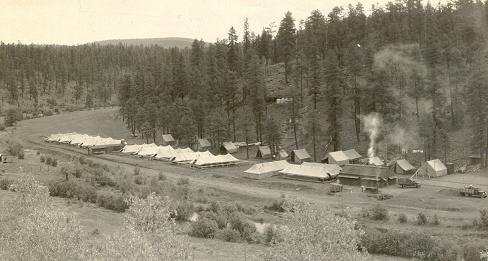
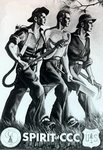
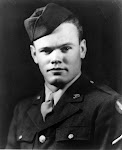





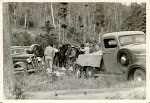
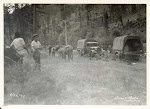


3 comments:
At no time did I receive any military training in the CCC ,except for the following.
Immediately following Pearl Harbor a company of Infantry from either Poughkepsie or Schnectedy ,N.Y. National Guard moved into camp.
Being only a kid(15 yrs.) this was a big deal to me.
I was friendly with a couple of the guys who taught me the Manual of Arms(including Queen Annes Salute) and How to Field Strip weapons such as the Garand Rifle and .45Cal. Colt Auto Pistol.
On entering the Army in Oct 1942 my 16th birthday ,I was a big man on campus among the other recruits because of my knowledge of weapons and the Manual of Arms.
Maybe for this reason I received less hazing than the others and was eventually put in charge of them.
A few years ago my wife and I located the old camp site, Camp #3220,Georgetown,Delaware.Walking thru the grass on the foundations of our old buildings was eerie to say the least.
We were a Soil Conservation Camp and today the site is the Headquaters of the Sussex County Soil Coservation Unit of Sussex County,Del.
We learned that the Camp became a Prisoner of War Camp for German Prisoners after it's closure in June 1942 and that only the previous year a German who had be held there came back to see the old camp.
When I enlisted in the CCC in Oct 1941 I was homeless so the CCC was a life saver for me.
I found your website while doing a little research on the German POW (CCC Camps). My father has told me stories of the camp that was here in Fruita at the base of the Colorado National Monument when he was a young boy of about 9. The camp here was named NM3C. He and some of his friends used to visit the camp and try to talk to the Germans. Some knew a little english, but I think my father and his friends were just taken by the thrill of being so close to the Germans. By his account they were friendly and very much enjoyed their time here working in the orchards, beet fields, and canning factories. It seems they would have had to be since they were being held in by a meager three stringed barbed wire fence and very little armed security. When the war was declared at an end and the Germans were being released, my father said that many of them did not want to be sent home and as a result, three German POW's escaped and hid out in a Loma haystack for several days until they were finally captured. I found an article online written by D.A.Brocket "CCC Camp Used as German POW Camp" that confirmed this story. My father came into possession of an handwritten and drawn invitation to a good bye party being held at the camp for the German POW's. The invitation which is on the back side of an 8x5index card is made out to a Cpl. Wilber E. Charlton and is signed by the German Company Leader, written in German, which I am unable to read. It is dated Nov.4, 1945 and reads "INVITATION CARD" across the top, then; "I have the honor to invite you to a company-party in the mess-hall at 3:30 o'clock P.M.". Drawn on the left side is a man with blond hair (colored with colored pencils it appears)wearing a red shirt and green pants with "PW" across the chest, on each arm, and on the upper pant legs. He is carrying a red suitcase which reads "To Home" and his other arm is raised above his head as if to be waving goodbye. In the background is a two stringed barbed wire fence attached to a post on the right side. The illustration is really quite good. I would imagine that it was a collaberation of the German POW's work as well as the soldiers/guards who may have assisted in the writing. Although unsure of how he came to possess this invitation, we surmise it may have been given to him by the guard as a keepsake, or dropped on the ground somehow and picked up by my father on one of his visits or possibly given to my grandfather who then later passed it on to my father. Whatever the case may be, it is a priceless piece of local history that I hope to learn more about and continue to pass my fathers story down the generations.
The comments posted here by Dragline and Pamela bring up the ironic fact that many former RAD members may have eventually ended up in former CCC camps as POWs after their capture during the war. Ironic too is the fact that some loved this country so much they didn't want to return to Germany at war's end.
Thank you both for dropping by.
Post a Comment